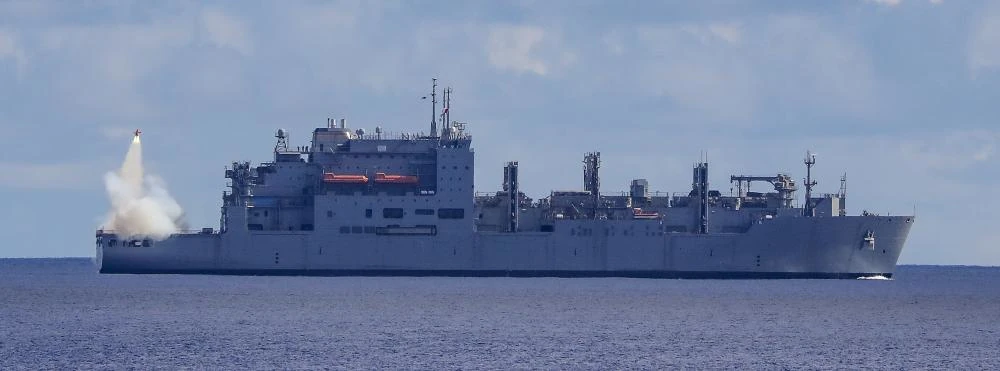The BQM-177A, the U.S. Navy’s next-generation subsonic aerial target (SSAT), gained full operational capability on August 28 with a successful conventional missile launch and intercept while participating in Pacific Vanguard 2022 (PV 22) in the Philippine Sea. It was launched for the target practice involving Standard Missile 2 (SM-2).
The BQM-177As were launched from the Lewis and Clark-class dry cargo ship USNS Alan Shepard (T-AKE 3) and engaged with missiles launched from the Arleigh Burke-class guided-missile destroyer USS Barry (DDG 52) and the Royal Australian Navy’s Anzac-class frigate HMAS Perth (FFH 157), marking the first use of the BQM-177A in the Western Pacific region and demonstrating the drones’ full operational capability.

PV 22-1 is the fifth iteration of the quadrilateral exercise series involving naval forces from Australia, Japan, the U.S. and South Korea. This exercise is designed to improve the US Navy’s capability in responding as a naval force to crises and emergencies in the area. The goal is for the participating fleets to continue to hone their abilities as an integrated force ready to react to the Indo-Pacific region’s evolving and complicated maritime environment.
CTF 71/DESRON 15 is the Navy’s biggest forward-deployed DESRON (Destroyer Squadron) and the primary surface force of the United States 7th Fleet.
The United States 7th Fleet conducts forward-deployed naval operations in support of US national interests in the Indo-Pacific region. As the United States Navy’s biggest numbered Fleet, the 7th Fleet works with 35 other maritime countries to develop relationships that improve maritime security, stability, and conflict prevention.
BQM-177A Sub-Sonic Aerial Target – SSAT
Developed by Kratos, the BQM-177A is an advanced high-subsonic, recoverable aerial target system. The Naval Air System Command (NAVAIR) Aerial Target and Decoy Systems Program Office oversee the SSAT Program (PMA-208).
While it delivers strong threat simulation for air-to-air engagements, the BQM-177A’s aerodynamic design and performance characteristics make it a good option for threat emulation of highly-dynamic, high-subsonic, sea-skimming anti-ship cruise missiles.
As per the company, the BQM-177A has no equivalent when it comes to offering genuine anti-ship missile threat simulation, with speeds exceeding 0.95 Mach, a sea-skimming height as low as 6.6 feet and manoeuvrability of -2 g – 9 g.
The BQM-177A, which is powered by a Safran Microturbo TRI 60-5 turbojet engine, can carry a range of internal and wing tip-mounted payloads. Electronic countermeasures, infrared, active and passive radar augmentation, friend-or-foe recognition, internal chaff and flare dispensing, threat-emitter simulators, smoke generators, and scoring systems are among them.
The BQM-177i is an exportable variation of the BQM-177A SSAT. The BQM-177i simulates high-subsonic, sea-skimming anti-ship cruise missile threats.
The BQM-177i has no competitive counterpart when it comes to offering genuine anti-ship missile threat simulation, with speeds exceeding 0.95 Mach and a sea-skimming altitude as low as 3.1 metres, states the company.
In July 2018, the NAVAIR Aerial Targets Program Office publicly approved Kratos’s first production BQM-177A target. The BQM-177A achieved initial operational capability (IOC) on February 27, 2019, when it was certified for land-based firing operations on the Point Mugu sea range in California.
BQM-177A replaces BQM-74E Chukar Targets. The BQM-74E Aerial Target is a remotely operated, recoverable subsonic aerial target capable of speeds up to Mach 0.86 and altitudes ranging from 7.0 to 40,000 feet. During the flight, the BQM-74E is driven by a single J400-WR-404 turbojet engine, which provides 240-pound thrust at full throttle at sea level. The BQM-74E is launched using two Jet Assisted Takeoff (JATO) bottles from a zero-length ground launcher. The BQM-74E may be launched from an F-16, Gulfstream (G-1), or DC-130A fitted with an air launch kit.
The BQM-177A is based on Kratos’ BQM-167X Aircraft, a variant of the BQM-167A Skeeter Target presently delivered to the United States Air Force. While retaining the BQM-167A’s historical designs, the BQM-177A incorporates a new fuselage with area ruling, high mounted wings, and an internally integrated MicroTurbo TR-60-5+ turbojet engine for decreased transonic drag.
